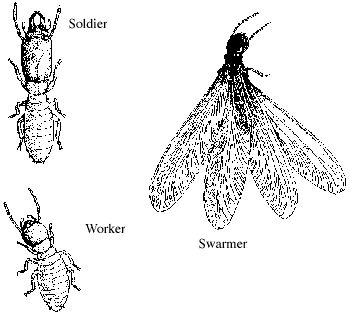Different types of termites
Termites have thrived on our planet for the past 250 million years. Technically, there are three major types of terrestrial termites that live in the United States: drywood; subterranean (ground); and Formosan. By far, the two most prevalent types of termites are the ground and drywood species. All types of termites survive by ingesting cellulose, found in wood and wood products. Termites live within highly organized social colonies much like their biggest adversary, the ant.

Drywood termites
prefer to live above the soil, taking up residence in wood structures such as trees, houses and even furniture. Once established, a colony of wood-inhabiting termites can slowly weaken a wooden structure, but the visible evidence of damage may not be noticeable for at least two years.
Ground termites
dwell within the soil, tunneling up to the surface in a complex system that allows the termites access to nearby food sources of wood. Members of the colony can fan out as far as 130 feet (39.6m) from the main living area to forage for food. Ground termites are voracious eaters; certain species are known to eat as much as 15 pounds (6.8kg) of wood each week! Pest control experts attribute 95% of the yearly damage done by termites in the United States to the soil tunneling type of termite.
Formosan termites (Coptotermes formosanus)
are relative newcomers to United States. Also a subterranean type of termite, this species that originated in East Asia, has become a threat to property and forests throughout a dozen southern states. Brought to this country in supplies returned to U.S. military bases after WWII, this species was not identified as separate from indigenous ground termites until the 1960s. Since 1998, southern states have embarked upon an aggressive program to eradicate the pest.
Evidence of a termite infestation includes finding "droppings," sand-like grains in the case of drywood termites, or "tubes," tunnel-like pathways leading from the ground to a wood source in the case of ground termites. In the spring, swarms may also indicate the presence of termites as they attempt to form a new colony during their winged stage. The elimination of termite colonies includes preventative measures such as education, building with treated wood, and completely sealing wooden structures. If an infestation is well established, the application of chemicals is required for eradication.
All types of termites maintain highly structured social orders. The colonies consist of workers, soldiers, winged termites, and king and queen termites. Worker termites are responsible for the care of the young and the construction and maintenance of the colony. Soldier termites' only function is to defend the colony from intruders, primarily ants. Winged termites, also known as reproductives, act as secondary offspring producers to the queen once the colony grows larger than the queen can supply. Both a king and queen are necessary to form a new colony; they assist each other in finding a new location and in producing the population of a termite colony.
While some estimates of the ravages of termite infestations within the United States are as high as 3 billion dollars a year, all types of termites provide considerable ecological benefits to the land. Termites provide sustenance and shelter for myriad types of life forms as they break down dead and dying trees, and they help aerate the soil for regeneration and future growth.







